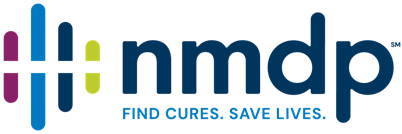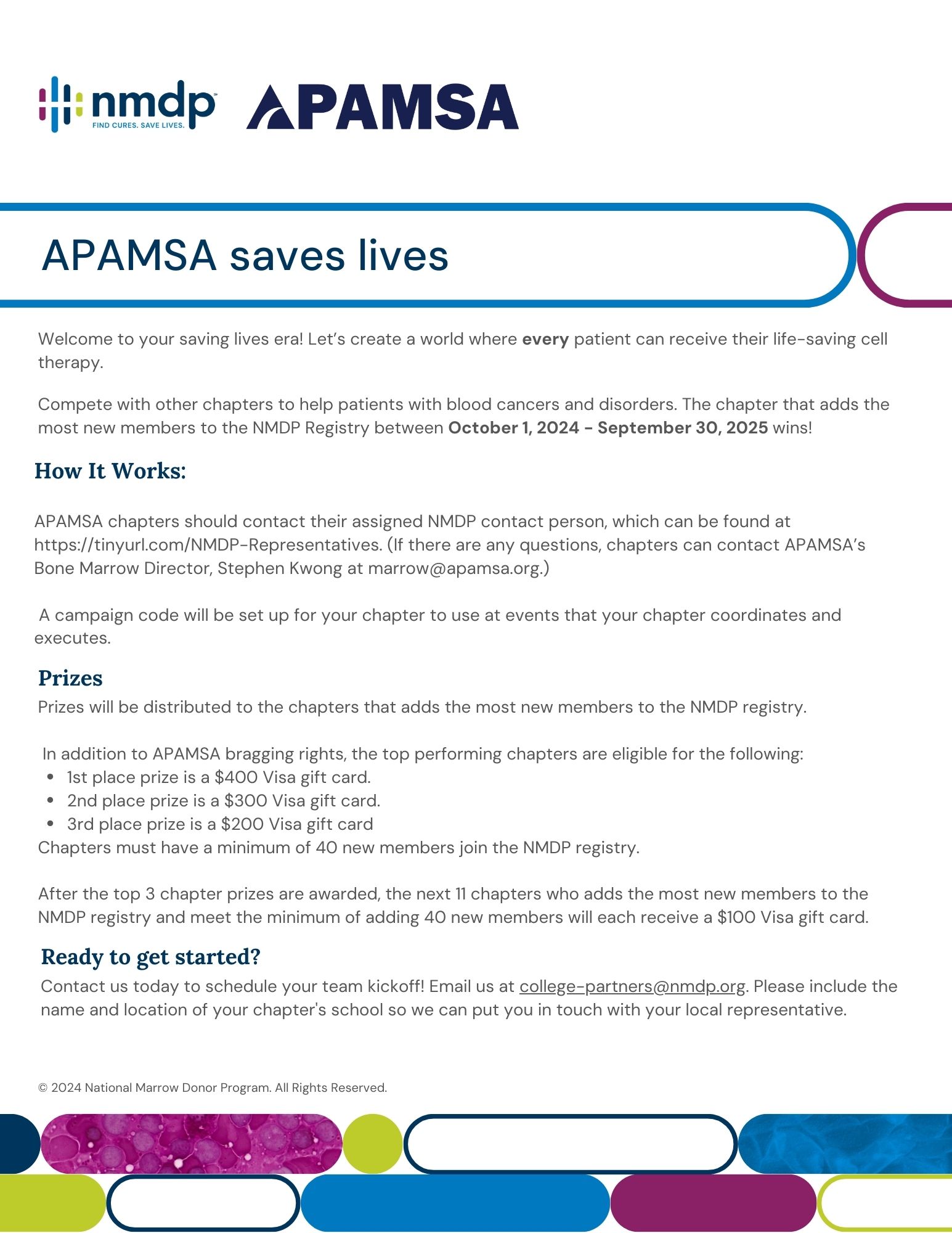Our Mission
Bone Marrow Registration
The goal of APAMSA’s National Bone Marrow Registration Initiative is to increase the representation of minority groups, especially AANHPI, in the national registry in the effort to offer a cure to thousands suffering from diseases treatable with stem cell transplant.
Questions? Contact the Bone Marrow Director, at Stephen Kwong, at marrow@apamsa.org.
Every three to four minutes someone in the U.S. is diagnosed with a blood cancer. A blood stem cell transplant can cure or treat more than 75 diseases, including blood cancers like leukemia and other blood disorders like sickle cell.
As a leader in cell therapy, NMDP SM connects thousands of patients every year with a matching donor for the chance at a life-saving transplant. Together, NMDP and APAMSA members are creating a world where blood cancer and other rare diseases are a thing of the past.
The NMDP x APAMSA Interchapter Competition is dedicated to spreading awareness about the mission and recruiting potential blood stem cell donors to the NMDP Registry SM to help save lives.
Date: October 1st, 2024 to September 30th, 2025
Winning Prizes and Inclusion Requirements: Up to 14 individual chapter prizes! See flyer below for more information.
How to join: Contact your APAMSA Chapter’s respective NMDP contact person listed (https://tinyurl.com/NMDP-Representatives)
Bone marrow drives that occur between September 2024 will count towards the 2024- 2025 competition. You may request funding for drives during this time frame, but it is first come first serve.
Feel free to contact APAMSA Bone Marrow Director (marrow@apamsa.org) with any questions!
Last updated: April 2025
Kits Returned
Total Kits Retuned: 842
We are excited to continue providing APAMSA members the opportunity to apply for the Marrow Grant through our partnership with NMDP. The purpose of this grant is to provide financial assistance (up to $150) to chapters interested in hosting their own recruitment events via NMDP. Grants will be awarded on a first come first serve basis until September 30, 2025. All applicants must be in communication with their NMDP representative prior to applying. Examples of fundable expenses include food/beverages to promote your drive or any supplies, posters, etc. needed for your drive!
You can find further information and the application here.
How long does it take to get on the blood stem cell registry?
It takes minutes to answer some simple questions about your medical history to make sure you meet health guidelines and to swab your cheeks. Once you’ve returned your swab kit to NMDP, it’ll take 6 to 8 weeks to be added to the registry. After that, you could be called for a patient anytime: in two months, one year or possibly longer.
What does it mean to be on the registry?
If you decide to join the registry, it’s important to stay committed. You could be a patient’s only match—their only hope for a cure. When you register, you’re committing to donating to any patient in the world, even if you’re joining on behalf of a specific person. If you match, you have the right to change your mind. But because a decision not to donate can be life-threatening to the patient, please think seriously about your commitment before joining the registry.
What’s the need for AANHPI patients?
Cancers and other diseases do not discriminate—they affect people of all ages and ethnic backgrounds, often with very little warning.
70% of patients needing a blood stem cell transplant don’t have a fully matched donor in their family. They depend on NMDP to find an unrelated donor—a selfless stranger who can step up and donate their healthy blood stem cells—for the chance at receiving a life-saving transplant.
Matching donors and patients has a genetic component; the best match for a patient is typically someone who shares their ethnic background. Because of the makeup of the registry, though, not all patients have the same chance of finding a match.
About 40% of potential donors on the NMDP Registry are ethnically diverse. However, the registry is not diverse enough to ensure every patient finds a match.
More AAHNPI donors are needed to help AANHPI patients.
What is the donation process like?
If you match a patient, there are two ways to donate blood stem cells. The patient’s doctor
chooses the donation method that’s best for the patient. About 90% of donations are PBSC, which is like donating plasma. In the days leading up to your PBSC donation, you’ll be given injections of filgrastim, a medication that increases the number of blood-forming cells in your bloodstream.
During donation, your blood goes through a needle on one arm and is passed through a machine that separates out the blood-forming cells. The remaining blood is returned to you through the other arm. Many donors play games or binge their favorite TV show to pass the time.
Marrow donations make up about 10% of total donations. Marrow donation is a surgical procedure where doctors use needles to withdraw liquid marrow (where the body’s blood-forming cells are made) from the back of your pelvic bone. You’ll be given anesthesia and won’t feel any pain while donating.
What happens if I get called to donate but don’t have the resources to cover medical expenses or travel?
It costs you nothing to join the registry or to donate. NMDP pays for all donation-related costs, including travel costs for you and a companion, medical appointments, lost wages, pet care and more.
I already am planning an event with another club at my school or already have a campaign code, do I still need to contact my NMDP representative?
Yes, you will still need to contact the NMDP representative for your APAMSA chapter. This is to create a unique registration code for your APAMSA chapter so your registrants can be counted for the Interchapter Competition.
What happens if I contact my local NMDP representative and change my mind about hosting a bone marrow drive?
Reaching out to your local NMDP representative is not binding. You are not required to host an event once you start communication. The meeting is simply an opportunity to discuss how your NMDP representative can help you reach your recruitment goals.
Am I allowed to team up with another APAMSA chapter?
You are permitted to work with your local premed APAMSA chapter if your school has one. If there is a barrier to your chapter working independently in the Interchapter Competition, please reach out to the Bone Marrow Director at marrow@apamsa.org. Partnership requests will be reviewed on a case-by-case basis.

According to Be The Match, every three minutes, someone in the U.S. is diagnosed with a blood cancer like leukemia. Over the course of each year, more than 30,000 children and adults will be diagnosed and need to find a transplant match. Yet only 30% of patients will find a matching donor within their families. The remaining 70% depend on the Be The Match Registry (also called the National Marrow Donor Program [NMDP] Registry) to search for an unrelated donor or umbilical cord blood unit. These numbers become frighteningly lower for patients of minority descent. For example, the likelihood of finding a match for those of API descent is 41%, compared to 77% for those of Caucasian descent.
Race and ethnicity matter when it comes to finding a matching donor. Patient and donor must have the same human leukocyte antigen (HLA) type in order for a successive transplant. HLA is a type of protein, or marker, found on most cells of your body. It helps the immune system identify which cells belong to the body and which do not. Because HLA is inherited, patients are most likely to match someone of their same race and ethnicity. Despite the millions of already registered donors, the need is never-ending. Some ethnic groups may have more complex tissue types than others and thus, are unable to find a match in the current registry because of the rarity of their tissue types.
Dr. Wendy Chen, a plastic surgeon, shares with us her family’s struggles in finding a bone marrow transplant match. She encourages those who can to become a bone marrow donor to help other families like hers. Click HERE for her interview
The large disparity for minorities to find a matched donor can be explained by a number of obstacles, including but not limited to:
-
-
Lack of awareness of marrow donation among minorities
-
Mistrust of marrow donation among minority groups
-
Language and/or cultural barriers
-
As a group, we can make a difference through
-
-
Hosting bone marrow registration drives each chapter’s school. If your chapter is interested in hosting, please contact the Bone Marrow Director at marrow@apamsa.org.
-
As of July 1, 2018, Be The Match has moved their registration completely digital. With this new process, chapter drive events will proceed a little bit differently. A local representative from the school’s area will lead engagement activities, including presenting overview information and answering any questions.
-
The potential registry member will either follow a personalized link by a text to join code, scan a QR code, or enter in the link and complete the registration form online.
-
A swab kit will be sent out to them directly from the lab.
-
-
Educating members about the cause and need for minority representation in the national bone marrow registry
-
Encouraging members to registry themselves
-
Change starts with US!
-
Use our personalized link: https://join.bethematch.org/APAMSA
-
-
Dispelling common misconceptions about bone marrow donation
-
Registering
To be eligible to donate, potential donors must be between the ages of 18 and 60 years old and meet the required health guidelines. Potential donors need to collect samples for tissue typing by swabbing the inside of their buccal (cheeks) and mailing back the prepaid envelope. They will also complete a brief health questionnaire and sign a consent form to have their tissue type listed on the Registry.
Donating
If chosen to donate, the donor will most likely undergo what is called a peripheral blood stem cell (PBSC) collection. Here’s how it works:
-
5 days before the actual donation, the donor will get a daily 5-minute injection of a white blood cell growth hormone known as granulocyte colony-stimulating factor (G-CSF).
-
On day 5, blood will be collected from the donor and filtered through a circulating machine. The machine will collect the stem cells and return the blood to the donor.
On certain occasions, donors may be asked to undergo a bone marrow harvest. This is what most people think when they think about bone marrow transplant. The physician will take bone marrow from the back of the donor’s hip bone during surgery. Usually, donors can return home the same day of the surgery and resume normal activity within 1 week.
The final result? The patient gets a chance of a cure.
Our vision for the future is to close the bone marrow donation gap. By increasing the diversity of the Be The Match registry, we can have a positive impact on the lives of so many individuals affected by bone marrow disease.
Please consider hosting a drive at your school and register today!

